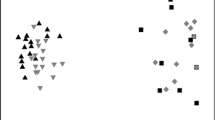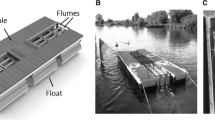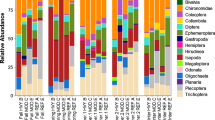Abstract
Biological invasions are regarded as a major threat to native ecosystems, yet studies investigating the interactions of invaders with native biota under field conditions are rare. Whilst many invaders are present only in low densities, it is often the effects of high densities that are of particular concern. We manipulated densities of the invading New Zealand aquatic snail Potamopyrgus antipodarum within an Australian stream to test the relationships between relatively high and low densities of the invading snail and other benthic fauna. Two experiments were carried out: the first experiment investigated the relationship between P. antipodarum and benthic fauna colonising within a short period of six days, the second looked at the effects after six days of high P. antipodarum densities on resident benthic fauna. In both experiments, there was no evidence of a negative relationship between densities of P. antipodarum and native fauna. On the contrary, both experiments showed a positive relationship between P. antipodarum densities and those of some common native fauna. In the second experiment invader densities were positively correlated with total number of native taxa, as well as with total densities and the densities of common invertebrates. Coprophagy is suggested as a possible mechanism by which increase in P. antipodarum could facilitate increase in native fauna. The results of this work strongly suggest that the effects of an invader can include indirect effects on the trophic dynamics of an ecosystem.
Similar content being viewed by others
References
Boettger CR (1951) —Die Herkunft und Verwandtschaftsbeziehungen der Wasserschnecke Potamopyrgus jenkinsi E.A. Smith, nebst einer Angabe über ihr Auftreten im Mediterrangebiet. Archiv für Molluskenkunde 80: 57–84
Boulton AJ, Spangaro GM and Lake PS (1988) Macroinvertebrate distribution and recolonization on stones subjected to varying degrees of disturbance: an experimental approach. Archiv für Hydrobiologie 113: 551–576
Bowler PA (1991) The rapid spread of the freshwater hydrobiid snail Potamopyrgus antipodarum (Gray) in the Middle Snake River, southern Idaho. In: Pister EP (ed) Proceedings of the Desert Fishes Council, Vol XXI (Twenty-First Annual Symposium), pp 173–182. Desert Fishes Council, Bishop, California
Brendelberger H (1997) Coprophagy: a supplementary food source for two freshwater gastropods? Freshwater Biology 38: 145–157
Calow P and Calow LJ (1975) Cellulase activity and niche separation in freshwater gastropods. Nature 255: 478–480
Cartwright D (1997) Preliminary guide to the identification of late instar larvae of Australian Ecnomidae, Philopotamidae and Tasimiidae (Insecta: Trichoptera). Cooperative Research Centre for Freshwater Ecology, Identification Guide No. 10, Thurgoona, Australia
Civeyrel L and Simberloff D (1996) A tale of two snails: is the cure worse than the disease? Biodiversity and Conservation 5: 1231–1252
ClarkeKR and Warwick RM (1994) Change in Marine Communities: An Approach to Statistical Analysis and Interpretation. Natural Environment Research Council, UK
Connor VM (1986) The use of mucous trails by intertidal limpets to enhance food resources. Biological Bulletin 171: 548–564
ConnorVM and Quinn JF (1984) Stimulation of food species growth by limpet mucus. Science 225: 843–844
Constantini ML and Rossi L (1998) Competition between two aquatic detritivorous isopods – a laboratory study. Hydrobiologia 368: 17–27
Dean JC (1997) Larvae of the Australian Hydrobiosidae (Insecta: Trichoptera). Cooperative Research Centre for Freshwater Ecology, Identification Guide No. 11, Thurgoona, Australia
Dean JC and Suter PJ (1996) Mayfly nymphs of Australia: a guide to genera. Cooperative Research Centre for Freshwater Ecology, Identification Guide No. 7, Thurgoona, Australia
Doeg T and Lake PS (1981) A technique for assessing the composition and density of the macroinvertebrate fauna of large stones in streams. Hydrobiologia 80: 3–6
Doeg T, Lake PS and Marchant R (1989) Colonization of experimentally disturbed patches by stream macroinvertebrates in the Acheron River, Victoria. Australian Journal of Ecology 14: 207–220
Downes BJ, Lake PS, Schreiber ESG and Glaister A (1998) Habitat structure and regulation of local species diversity in a stony, upland stream. Ecological Monographs 68: 237–257
Flecker AS and Townsend CR (1994) Community-wide consequences of trout introduction in New Zealand streams. Ecological Applications 4: 798–807
Gordon ND, McMahon TA and Finlayson BL (1992) Stream Hydrology: an Introduction for Ecologists. Wiley, Chichester, UK
Griffiths RW (1993) Effects of Zebra Mussels (Dreissena polymorpha) in shallow water of northeastern Lake Erie. In: Nalepa TF and Schloesser DW (eds) Zebra Mussels. Biology, Impacts and Control, pp 415–437. Lewis Publishers, Boca Raton, Florida
Griffiths RW, Schloesser DW, Leach JH and Kovalak WP (1991) Distribution and dispersal of the Zebra Mussel (Dreissena polymorpha) in the Great Lakes Region. Canadian Journal of Fisheries and Aquatic Sciences 48: 1381–1388
Hawking JH (1994) A preliminary guide to keys and zoological information to identify invertebrates from Australian freshwaters. Cooperative Research Centre for Freshwater Ecology, Identification Guide No. 2, Thurgoona, Australia
Herndl GJ and Peduzzi P (1989) Potential microbial utilization rates of sublittoral gastropod mucus trails. Limnology and Oceanography 34: 780–784
Hubendick B (1950) The effectiveness of passive dispersal in Hydrobia jenkinsi. Zoologiska Bidrag från Uppsala 28: 493–504
Huryn AD (1998) Ecosystem-level evidence for top-down and bottom-up control of production in a grassland stream system. Oecologia 115: 173–183
Jackson J (1998) Preliminary guide to the identification of late instar larvae of Australian Calocidae, Helicophidae and Conoesucidae (Insecta: Trichoptera). Cooperative Research Centre for Freshwater Ecology, Identification Guide No. 16, Thurgoona, Australia
Lake PS (1990) Disturbing hard and soft bottom communities: a comparison of marine and freshwater environments. Australian Journal of Ecology 15: 477–488
Lake PS and Doeg TJ (1985) Macroinvertebrate colonization of stones in two upland southern Australian streams. Hydrobiologia 126: 199–212
Langenstein S and Bowler PA (1991) On-going macroinvertebrate analysis using the biotic condition index and the appearance of Potamopyrgus antipodarum (Gray) in Box Canyon Creek, southern Idaho. Proceedings of the Desert Fishes Council, Vol. XXI (Twenty-First Annual Symposium) pp 183–194. Desert Fishes Council, Bishop, California
Lodge DM, Stein RA, Brown KM, Covich AP, Brönmark C, Garvey JE and Klosiewski SP (1998) Predicting impact of freshwater exotic species on native biodiversity: challenges in spatial scaling. Australian Journal of Ecology 23: 53–67
MackMC and D'Antonio CM (1998) Impacts of biological invasions on disturbance regimes. Trends in Ecology and Evolution 13: 195–198
McIntosh AR and Townsend CR (1996) Interactions between fish, grazing invertebrates and algae in aNewZealand stream: a trophic cascade mediated by fish-induced changes to grazer behaviour? Oecologia 108: 174–181
Ponder WF (1988) Potamopyrgus antipodarum – a molluscan coloniser of Europe and Australia. Journal of Molluscan Studies 54: 271–285
Ponder WF (1994) Australian Freshwater Mollusca: conservation priorities and indicator species. Memoirs of the Australian Museum 36: 191–196
Quinn GP, Lake PS and Schreiber ESG (1998) A comparative study of colonisation by benthos in a lake and its outflowing stream. Freshwater Biology 39: 623–635
Ricciardi A, Whoriskey FG and Rasmussen JB (1997) The role of the Zebra Mussel (Dreissena polymorpha) in structuring macroinvertebrate communities on hard substrata. Canadian Journal of Fisheries and Aquatic Sciences 54: 2596–2608
Roditi HA, Strayer DL and Findlay S (1997) Characteristics of zebra mussel (Dreissena polymorpha) biodeposits in a tidal freshwater estuary. Archiv für Hydrobiologie 140: 207–219
Sala OE, Chapin III S, Armesto JJ, Berlow E, Bloomfield J, Dirzo R, Huber-Sanwald E, Huenneke LF, Jackson RB, Kinzig A, Leemans R, Lodge DM, Mooney HA, Oesterheld M, Poff LeR N, Sykes MT, Walker BH, Walker M and Wall DH (2000) Global biodiversity scenarios for the year 2100. Science 287: 1770–1774
Shepard RB and Minshall GW (1981) Nutritional value of lotic insect feces compared with allochthonous materials. Archiv für Hydrobiologie 90: 489–491
Simberloff D and Stiling P (1996) Risks of species introduced for biological control. Biological Conservation 78: 185–192
Smith BJ (1996) Identification keys to the families and genera of bivalve and gastropod molluscs found in Australian inland waters. Cooperative Research Centre for Freshwater Ecology, Identification Guide No. 6, Thurgoona, Australia
StClair RM (1997) Preliminary guide to the identification of late instar larvae of Australian Philorheithridae, Calamoceratidae and Helicopsychidae (Insecta: Trichoptera). Cooperative Research Centre for Freshwater Ecology, Identification Guide No. 12, Thurgoona, Australia
Stewart TW and Haynes JM (1994) Benthic macroinvertebrate communities of southwestern Lake Ontario following invasion of Dreissena. Journal of the Great Lakes Research 20: 479–493
StewartTW, Miner JG and LoweRL(1998) Quantifying mechanisms for zebra mussel effects on benthic macroinvertebrates: organic matter production and shell-generated habitat. Journal of the North American Benthological Society 17: 81–94
Strayer DL (1999) Effects of alien species on freshwater mollusks in North America. Journal of the North American Benthological Society 18: 74–98
Strayer DL, Caraco NF, Cole JJ, Findlay S and Pace ML (1999) Transformation of freshwater ecosystems by bivalves: a case study of zebra mussels in the Hudson River. Bioscience 49: 19–27
Thomas MB and Willis AJ (1998) Biocontrol – risky but necessary? Trends in Ecology and Evolution 13: 325–329
Vermeij GJ (1996) An agenda for invasion biology. Biological Conservation 78: 3–9
Williamson M (1996) Biological Invasions. Chapman & Hall, London, 244 pp
Wisenden PA and Bailey RC (1995) Development of macroinvertebrate community structure associated with the Zebra Mussel (Dreissena polymorpha) colonization of artificial substrates. Canadian Journal of Zoology 73: 1438–1443
Wolf B, Zwick P and Marxsen J (1997) Feeding ecology of the freshwater detritivore Ptychoptera paludosa (Diptera, Nematocera). Freshwater Biology 38: 375–386
Author information
Authors and Affiliations
Rights and permissions
About this article
Cite this article
Schreiber, E., Lake, P. & Quinn, G. Facilitation of Native Stream Fauna by an Invading Species? Experimental Investigations of the Interaction of the Snail, Potamopyrgus antipodarum (Hydrobiidae) with Native Benthic Fauna. Biological Invasions 4, 317–325 (2002). https://doi.org/10.1023/A:1020925022843
Issue Date:
DOI: https://doi.org/10.1023/A:1020925022843




